About the author
John A. Graham is an American musicologist (PhD. Princeton University 2015) who specializes in the history of Georgian liturgical polyphony. His publications can be found at http://www.johnagraham.com/publications/
Maksime Sharadze (1859-1908)
Publisher, Cultural activist, Organizer
See original 2005 publication of this article here.

Maksime Sharadze remains a relatively unknown figure to historians. Few personal artifacts, photographs, or written accounts about his private life survive.[8] He was from a town called Etseri in the Gurian province in western Georgia, an only child and an orphan. As a young man, he moved to Tbilisi and quickly became the chief publisher and editor of a major daily newspaper, the Iveria, a member of numerous organizations, as well as the personal housekeeper for the Iveria owner and influential nationalist writer Ilia Chavchavadze. He never married, but in later years chose to live an ascetic and moralistic lifestyle among friends, sharing possessions, expenses, and living quarters.[9]
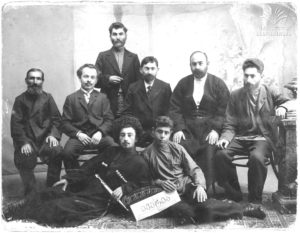
When only twenty-three years old, Sharadze formed the Cabinet brotherhood, a loose collective of men dedicated to the advancement of Georgian culture and Georgian art. In his own words, Sharadze said,
“Wouldn’t it be wonderful to open a free library for the advancement and education of working class people? And also, to learn our Georgian church chant? …I receive a salary of twenty five rubles per month; I would give it all for the preservation of our chant.”[10]
Though it is not known whether Sharadze had any connection with early socialist groups in Tbilisi, his written words, group life-style, and focus on ordinary people suggests a familiarity with socialist thought.[11] The brotherhood rented a space to begin a library, outlined a mission statement and charter for membership, and began publishing pamphlets of poetry and tracts.
In the words of his longtime friend and colleague Ekvtime Kereselidze, “Because of his honesty and generosity everyone loved Maksime. In the entire city, those who knew him trusted him; one couldn’t find anyone who would say a bad thing about Maksime. He was forever cheerful, polite, reliable, and generous, always ready with a helping hand.”[12]
His popularity made him suspicious however, and soon after the Cabinet opened, Russian authorities jailed Sharadze for three days accusing him of inciting social and religious unrest. While the State was suspicious of activities related to a growing Georgian nationalist fervor in Tbilisi at the time, they could not find fault with Sharadze’s charitable work in the Cabinet and released him under supervision.
Even from the inception of the Cabinet, Sharadze had spoken out about becoming involved in saving the chant tradition, but his true inspiration came three years later: Saint George’s Day, November 1885. “At a service in Kashweti Church, Tbilisi, he [M.S.] was brought to tears when he heard the troparion to Saint George sung in the old Georgian manner of church singing,” wrote Kereselidze.[13]
Astonished and moved by the simplicity, prayer, and beauty of the service chant, he approached the director of the choir, Melchesidek Nakashidze, and arranged for chant lessons at the Cabinet. This event led to important connections between key scholars and chanters such as Pilimon Koridze and Anton Dumbadze, and eventually to the first successful transcriptions and publications of medieval chant.
Three aspects of Sharadze’s work in connection with the chant preservation movement need to be highlighted.
- 1) His pragmatic initiatives to facilitate preservation activities, such as publishing, fundraising, and the events revolving around the Cabinet collective.
- 2) His charismatic popularization of the chant preservation movement through public speeches, written articles, and sponsored events.
- 3) His personal inspiration and financial support for important leaders such as Pilimon Koridze and Ekvtime Kereselidze.
Chant Preservation Movement
The meeting with Nakashidze brought Sharadze into contact with everyone working to save chant. In 1860, Alexander Okropiridze, a highly educated Orthodox bishop sympathetic to Georgian resentment of imperialist church policies, acted on his growing unease concerning the disappearing chant tradition by forming the Commission to Preserve Georgian Church Chant.[14] The Commission attempted to focus public attention on the declining tradition through articles and conferences, and sponsored the first transcription efforts of Georgian chant into western five line notation, a measure seen as a possible preservation tool.
Several people tried to transcribe chant including the composer Ivanov-Ipolatov, but after repeated disappointment with their efforts, Okropiridze was forced to offer a 500 Ruble guarantee to the first person that could successfully and seriously transcribe chants.[15] The problem lay in the fact that the musicologist-composers trained in western notation knew next to nothing about the polyphonic structure or unique tuning of Georgian music, while the chant prompters knew very little about the process of transcription into music notation.
In 1878, Bishop Okropiridze organized an exposition between the last of the eastern and western chant choirs.[16] Melchesidek Nakashidze, an aristocrat from the Gurian province, was one of the members of the western Georgian choir. He quickly became involved in the publicity and transcription efforts, and was the first master chanter to be involved with Pilimon Koridze, the man who would transcribe nearly five thousand chants between 1884-1911. The Karbelashvili brothers, who learned from their father Grigol Karbelashvili, were the only representatives that could be found to sing eastern Georgian chant.
After meeting Maksime Sharadze in 1885, Nakashidze began to teach the core of artists and writers who had gathered to form the Cabinet Collective in Tbilisi. Sharadze was a gifted leader, and felt that the only way to preserve chant was for people to dedicate themselves to the study of singing. He worked extremely hard to train himself and the Cabinet members to chant under the instruction of Nakashidze. “Maksime [Sharadze] learned the chants more quickly and with more talent than anyone else. Because of this, Melchesidek allowed him to give lessons to the other men in the mornings” (Kereselidze).[17]
Study of chant continued for six years at the Cabinet but a critical question persisted: how to preserve the tradition indefinitely? To become a ‘sruligalobeli’ (master-chanter) required five to six years of apprenticeship, the regimen of memorized chants extending beyond the hundred basic hymns for the liturgy and eight tone system to include hymns from the Great Feast days, special troparia for saints, as well as dozens of less common hymns for church events such as funerals, marriages, and baptisms. In the changing social climate of the late nineteenth century, as western music became the wave of the future in an increasingly international Tbilisi, and as the feudal structures and customs of medieval Georgia were left behind, the age of the master chanters was coming to a close.
Western notation, called ‘Russian notes,’ were known to composer musicians in Tbilisi as the first generation of Russian trained conservatory graduates returned from Moscow and St. Petersburg, but it was generally associated with western symphonic and operatic music. Early attempts to transcribe the odd tuning and unusual harmonies of Georgian folk and sacred music were unsuccessful, probably because the singers were unaccustomed to notation, and the transcribers were unused to Georgian vocal music. Bishop Okropiridze, who did not have musical training, nevertheless believed that western notation might contain the key to preserving the original Georgian song traditions.
Hope arrived when Pilimon Koridze, a famous Georgian opera singer returning from Italy and St. Petersburg, met master chanter Nakashidze in Tbilisi and began experimenting with transcription. At first, Nakashidze brought his chanting friends and sang difficult contrapuntal western Georgian hymns, but with Koridze’s coaching, the choir soon learned to sing simply and slowly. Koridze, once a seminary student, had been familiar with Georgian chanting, and his keen musical ear soon readjusted to the nuances of Georgian singing. Together they dedicated themselves to proving that transcriptions in ‘Russian notes’ might work as a preservation vehicle. Traveling to the city of Kutaisi in 1884, Koridze demonstrated in front of a gathering of clergy and master chanters how he could teach a choir of non-trained chanters to sing from western notation. An excited audience applauded his work but wondered, ‘why did the hymns sound out of tune?’
Unfortunately, western staff notation was not adequate to capture the nuances of the unique Georgian tuning system, but nevertheless had to suffice as a major step towards preservation. It is important to note that the master chanters present in Kutaisi, though representing different schools of chant in western Georgia, agreed that there were errors not just in tuning, but also in notation, thereby implying an understood basic structure common among the schools.[18]
This important demonstration and the discussions which followed led to a commission for a major transcription effort, organized by Bishop Gabriel Kikodze of Kutaisi during the years 1885-1887, and financed outside of the knowledge of the Russian appointed clerical exarchs. Koridze was commissioned to lead the transcription effort. For two years he recorded from the western Georgian master chanters Anton Dumbadze, Razhden Khundadze, Ivliane Tsereteli, and Dimitri Chalaganidze, who represented respectively the Shemokmedi, Gelati, Khobi, and Martvili monastery schools of chant.
In Tbilisi, news of Koridze’s success with transcription produced a great deal of excitement. The Cabinet had evolved into a publishing house for Georgian literature, poetry, and Orthodox moralistic teachings, and while Sharadze continued to learn and teach chant with the other Cabinet members, his perspective on the preservation movement was shifting. He began to realize that the practice of chant, even the transcription of chant would not be enough to ensure preservation into the future. The transcriptions needed to be published.
Without a single press in the country capable of printing musical notation, Sharadze turned to the connections of his influential friend Ilia Chavchavadze, and in 1891, wrote a letter to Professor Alexander Khakhanashvili in Moscow asking for advice on obtaining a complete set of music typeface. “If the typeface is not too expensive,” Sharadze wrote, “I can pay cash right away, but if it is expensive, we will need to search for further funds. However, my direction is clear; whether sooner or later, I am absolutely dedicated to fulfilling my commitment to publish Georgian chant!”[19] The realization that publication could potentially be a major vehicle in preserving Georgian chant became the guiding inspiration for Sharadze’s future career and work.
Publication
At the same time that Maksime Sharadze was attempting to order a print set of music typeface from Russia, he came into contact with Pilimon Koridze, the opera performer now famous for his transcription skills. Koridze had continued his transcription work in Kutaisi even after funding ran out for the 1885 project, but when his Ukrainian wife died in 1891, he returned to Tbilisi. Without career, family,[20] or home, Koridze considered returning to Italy where he had once enjoyed a reputable opera career, but a meeting with the charismatic Sharadze and the Cabinet changed his mind. As Kereselidze remembers of that time,
“Pilimon [Koridze] came to us and said, ‘I’ve just arrived in Tbilisi, and I don’t even have a place to stay.’ Maksime [Sharadze] said to him, ‘Pilimon, please, teach us how to read western notation! We will find you a house; pay a salary, anything you need. We are ready to dedicate ourselves to the study of chant and we want to be able to read the new transcriptions.”[21]
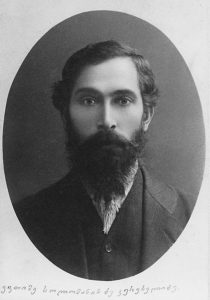
Not only did Sharadze keep his promise, finding Koridze an apartment with running water and other amenities, but he also organized a paid position for him to teach chant and transcription to members of the Cabinet. Befriending Koridze and keeping him involved in the preservation movement was one of Sharadze’s inadvertent acts of genius. Koridze would later go on to transcribe the majority of chant that has survived into the twenty-first century, a total of nearly five thousand individual hymns.[22]
The music typeface arrived in 1892. Sharadze wrote a second letter, this time to Bishop Gabriel Kikodze in Kutaisi, asking permission to print the chant transcriptions from Koridze’s work in the mid 1880s. In the letter, Sharadze expressed concern for the fragility of single copies of chant, suggesting that publication of the transcriptions into hundreds of copies would increase their safety.[23] The bishop readily agreed to the request, and trusting in a man he had never met, he sent the precious chant transcriptions to the Cabinet in Tbilisi.
In 1895, after several years of experimenting with the music typeface and waiting for additional materials from Moscow, the Cabinet succeeded in printing the first book of Georgian chant; a press run of fifteen hundred copies of medieval liturgy chant from the Gelati school. For chant preservationists of the period, it was a publication analogous to the first Gutenberg Bible.
More than anyone else, Sharadze realized the practical importance of undertaking such an enormous publication project. Many hundreds of hymns were already transcribed, with countless more held in knowledge by a small group of aging master chanters. Whereas perhaps hundreds if not thousands of competent master chanters were alive just one hundred years previous, by 1893 there were less than a dozen in the whole country. Many regional variations of chant, developed uniquely through the centuries, were already completely lost. The time was imminent to attempt the preservation of the last known chant repertoires.
With Sharadze’s urging, Pilimon Koridze decided to become active again as a field transcriber, and moved to the remote western Georgian province of Guria. There he worked with Anton and Davit Dumbadze, who were members of a famous master chanting family. In Tbilisi, Sharadze agreed to find salaries for both Koridze and the prompting chanters, but with limited resources of his own to pay the salaries, the project’s success depended on the benevolence of wealthier urbanites. So, in addition to his continuing duties as editor in chief of the daily Iveria newspaper, housekeeper for Ilia Chavchavadze, and director of the Cabinet, Sharadze began a public awareness and fundraising campaign. As an example of his style, he wrote in this public article from 1894,
“Today, on the 16th of this month, Mr. Pilimon Koridze is going to the city of Ozurgeti. As one will see, two strong patriots, Koridze, who can transcribe our chants into notation as clearly as a photograph, and Mr. Anton Dumbadze, a master chanter unique in all the land, these two men will meet…. When useful and charitable activity is begun, one may clearly see and understand the nature of a human being; one may see introspectively the motivation of one’s work, in honesty, clearness of heart, and whether these qualities are matching between word and deed. Each one of us must help and support the efforts of these great men in this manner, to show our true selves and to demonstrate whether we believe in goodness or not.” Signed, galobis erti mokhvarultagani (Just one admirer of chant)[24]
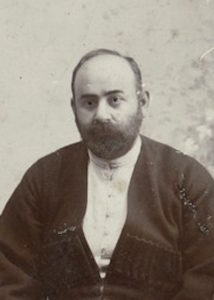
Through articles, events, and personal connections, Sharadze was able to solicit the necessary donations and increase public awareness of the chant preservation movement. He made it his personal responsibility to pay Koridze and his chanting prompters salaries and in 1894, for example, Sharadze was able to raise more than six hundred rubles.[25] Though the Cabinet was supposed to be a socialist experiment in shared resources, with members volunteering and paying dues, Kereselidze writes, “While many friends were attending the Cabinet, no one else paid dues to support the financial end of the business. Maksime [Sharadze] was paying for all of the expenses and not asking for anything.”[26]
At the turn of the century, Tsarist authorities attempted to censor Sharadze, revoking his publication permit. In despair, Sharadze was unable to continue his work until a well-connected friend, Aristovle Kutateladze, risked himself by reopening the press in his name and re-hiring all the same staff.
Inspiration
Sharadze continued to support Pilimon Koridze for many years, even buying him a small portable organ to facilitate transcription work. Besides monetary support, Sharadze used his gifts of inspirational writing to energize popular respect for the aging stage-singer turned village chant-transcriber. Koridze received many accolades in the media, and in addition to the chant transcriptions, the Cabinet published several of Koridze’s written works, notably a small book on the pedagogy of western musical notation.

Sharadze’s attention to detail in garnering public fame for Koridze’s transcription work showed his depth of love for the chant movement and a deep understanding of his friend. Koridze was a man accustomed to fame, and yet, having given up a career in the headlines, he was pursuing what he considered a much nobler cause. Sharadze made sure that his friend continued to receive attention from the public, and Koridze wrote inspirational letters from the field. This reciprocal relationship inspired them to keep working, year after year. In one letter to his friends at the Cabinet, Koridze wrote these passionate words, “I have been many places in the world, but of any place these are the most beautiful, most complicated chants I have ever heard. Day and night I pressure myself to work and work and work…. I don’t want to lose any more of these chants.”[27] He sent hundreds of handwritten transcriptions back to Tbilisi where, as master of editing and music typeface for the Cabinet, Kereselidze worked diligently to organize them into chant collections for publication.
In the years that Koridze was working in the village with master chanter Anton Dumbadze, Kereselidze and Sharadze became close friends as they worked together to publish the transcriptions. They both lived near the press and worked there daily. Together they learned chants and sang in a nearby church choir. After 1910, in the era following Sharadze’s transcription and publication projects, Kereselidze became the sole caretaker for the boxes and boxes of Koridze’s transcriptions. Traveling from monastery to monastery between the years 1912 to 1936 and working in secret, Kereselidze was to complete a monumental task of organizing and recopying the rough transcriptions. In 1936 the results of the preservation movement were handed over to a pair of astonished museum directors: five thousand, five hundred and thirty two hymns delicately hand copied into five leather bound books.[28]
For this inspired work, a story equally fascinating and worth telling, Kereselidze credits Sharadze, the man who inspired and motivated him. In a book written near the end of his life about the preservation movement (1941), Kereselidze begins,
“In my life I only had one true ‘heart-friend,’ Maksime, son of Rostom Sharadze who, unfortunately, lived only a short life. In all my other days, I was tortured by evil people; many times I was hungry, thirsty, naked, sick, even in jail… but all of this time I have been trying to collect these beautiful chants in order to save them for the future.”[29]
Sharadze’s natural ability to inspire those around him pushed key people to engage in the preservation movement. During the years 1895-1908, the Cabinet Press successfully printed four collections of medieval Georgian chant transcribed from master chanters representing the Gelati, Martvili, and Shemokmedi monastery schools in western Georgia, and one collection of Karbelashvili family chants representing the Davit Garegi monastery school from Eastern Georgia.[30] The sixth publication was interrupted by Sharadze’s untimely death in 1908 as, like many other people working with the chemicals of the printing business, he succumbed to tuberculosis and could not recover. The Cabinet brotherhood, which he had so competently managed, fell apart. Pilimon Koridze, already an elderly man, died in 1911.
Retrospective
The work of these men, locked away for almost half a century in state archives, is now becoming available and popularized again by groups such as the Anchiskhati church choir in Tbilisi. However, many of the chants transcribed by Koridze, the Karbelashvili Brothers, and others are still unpublished, unorganized, and in nearly the same condition as one hundred years ago. Interestingly, a little known manuscript of transcriptions by Sharadze dating to 1898 and numbering an impressive 840 pages, hints that he was more of a musicologist than sources reveal.[31] This inspires the question, if Sharadze himself knew how to transcribe chant, why didn’t he personally undertake the prestigious transcription work with master chanters such as Anton Dumbadze?
Sharadze once wrote, “There are many admirable attributes of mankind, but none more worthwhile than compassion. Acts of compassion have the ability to make not only he who is acting but also he who is receiving feel both blessed and joyful.”[32]
Sharadze was a man focused on helping other people, and helping his country. In looking at his accomplishments as print master, financier, and as catalyst for public support of the preservation movement, one recognizes that Sharadze sacrificed fame for what he understood to be the practical necessities of the movement.
In addition to singing and transcribing, he personally initiated and financed the printing and publication of several major books of chant as well as the salaries of the musicians most crucial to the last decade of chant transcription work. He was the personal inspiration for important figures Pilimon Koridze and Ekvtime Kereselidze, both of whom are honored as major contributors to the collection and understanding of medieval chant today.
A monumental task, comparable to Sharadze’s own, awaits those who work diligently at chant preservation and revival nearly one hundred years after his death. The chant publications of the Cabinet produced between 1895-1906 are slowly being republished, but there are thousands of manuscripts still to be researched.[33] But for this work, there are Kereselidze’s inspiring words, “In these books, there are many chants I could not finish, some that are only in one voice, some that we could not harmonize completely. What beautiful chants! It would be so wonderful to finish them, that we could have proof of Georgia’s treasure as a memorial for the generations yet to come!”[34]
NOTES
[8] L. Togonidze interview, Nov. 2004. It is believed that Sharadze’s personal archive was kept by Ekvtime Kereselidze, but lost after Kereselidze’s death.
[9] Ekvtime Kereselidze, Kartul Saeklesio Sagaloblebis Notebze Gadaghebis Istoria, ‘History of the Transcription of Georgian church chants,’ 1936, K. Potskhverashvili private archive, (Translated Togonidze, Graham, Nov 2004). This is the primary source for biographical information about Maksime Sharadze and is therefore referenced frequently.
[10] Ekvtime Kereselidze, Kartul Saeklesio Sagaloblebis Notebze Gadaghebis Istoria, ‘History of the Transcription of Georgian church chants,’ 1936, K. Potskhverashvili private archive, p18, (Translated Togonidze, Graham, Nov 2004).
[11] L. Togonidze interview, Nov. 2004
[12] Ekvtime Kereselidze, Kartul Saeklesio Sagaloblebis Notebze Gadaghebis Istoria, ‘History of the Transcription of Georgian church chants,’ 1936, K. Potskhverashvili private archive, p3, (translated Togonidze, Graham, Nov. 2004)
[13] Ekvtime Kereselidze, Kartul Saeklesio Sagaloblebis Notebze gadaghebis istoria, ‘History of the Transcription of Georgian church chants,’ 1936, K. Potskhverashvili private archive, (translated Togonidze, Graham, Nov. 2004)
[14] Poliekvtos Karbelashvili, “Kartuli Saero da Sasuliero Kiloebi, Istoriuli Mimokhilva Mrvdlis,” ‘Georgian secular and ecclesiastical modes,’ Tbilisi, 1899.
[15] Poliekvtos Karbelashvili, “Kartuli Saero da Sasuliero Kiloebi, Istoriuli Mimokhilva Mrvdlis,” ‘Georgian secular and ecclesiastical modes,’ Tbilisi, 1899.
[16] Togonidze interview, Nov 2004. The event was billed as a ‘competition’ between east and west, purportedly to determine which variant was more authentic. The faux debate, used to bring two choirs into the public spotlight, was put to rest by the ancient director of the western Georgian choir M. Chkhatarashvili. After listening closely to the eastern Georgian chants, he exclaimed, “Why did you bother to bring us here [from Guria]? You have the same chants that I know.” This observation supports the theory that Georgian chant shares common roots.
[17] Ekvtime Kereselidze, Kartul Saeklesio Sagaloblebis Notebze Gadaghebis Istoria, ‘History of the Transcription of Georgian church chants,’ 1936, K. Potskhverashvili private archive, (translated Togonidze, Graham, Nov. 2004)
[18] Ekvtime Kereselidze, Kartul Saeklesio Sagaloblebis Notebze Gadaghebis Istoria, ‘History of the Transcription of Georgian church chants,’ 1936, K. Potskhverashvili private archive, p14 (translated Togonidze, Graham, Nov. 2004). The source notes that the master chanters present were dissatisfied in particular with renditions of Romelni Kerubimta, Da Vitartsa, and Shen Gigalobt.
[19] Letter to Alexander Khakhanashvili from Maksime Sharadze, (from the Khakhanishvili private archive in the Institute of Handwriting). Doc. #698, Feb 7th, 1893 (translated Togonidze, Graham, Mar. 2005)
[20] Two Koridze children were in boarding school in Italy
[21] Ekvtime Kereselidze, Kartul Saeklesio Sagaloblebis Notebze Gadaghebis Istoria, ‘History of the Transcription of Georgian church chants,’ 1936, K. Potskhverashvili private archive, p21 (translated Togonidze, Graham, Nov. 2004)
[22] It is estimated that with the contributions of other transcribers such as the Karbelashvili brothers, Khundadze, Kereselidze, Sharadze, and others, eight thousand hymns survive. The majority of chant variations from unrepresented regions such as Svaneti, Racha, Ajara, Hereti, and other regions did not survive.
[23] Maksime Sharadze, Letter to Bishop Gabriel: 1891 (original in Russian), Kutaisis Sentraluri Sakhemtsipo Arkivi, Pondi #21, sakme #12544, ‘Central State Archive of Kutaisi’, ‘Fund #21, document #12544’ (translated Togonidze, Graham, Apr 2005)
[24] Maksime Sharadze, Iveria Daily, #125, 1893, “Galobnis notebze gadarkhebis shesakheb,” ‘About Transcribing Chant into Notation’ (translated Togonidze, Graham, Apr 2005). Full quote is as follows: “Today, on the 16th of this month, Mr. Pilimon Koridze is going to the city of Ozurgeti. As one will see, two strong patriots, Koridze, who can transcribe our chants into notation as clearly as a photograph, and Mr. Anton Dumbadze, who is a master chanter, unique in all the land, these two men will meet and say to each other, ‘Tskhaloba da mshvidoba (‘Blessings and Peace to all) and kiss each other.’ Tomorrow two of the great masters, one of musical notation, and the other of chants, will greet each other and share their wishes and dreams. Tomorrow they will decide the fate of Georgian chant, and with diligent, hard-working dedication and enthusiasm they will proceed. True men who listen to their hearts beating tomorrow, will understand that these two men, in their hearts, are supporting each other, helping each other, and at the same time, challenging each other. We will see who maintains the joy of working longest, until the project is finished and all the chants transcribed. Who among you can see what a beautiful treasure these chants are; a crown for the church and for the people? The church is not complete without chant; and without faith, the church, and acts of goodness and compassion, what is the future of humanity? Without these things, our earthly life is nothing; it is like a little child’s tree-house, built in a day to collapse the next. Man has been created to give charity, but who will do good deeds? Only that person who can say to himself, ‘I am content.’ Whosoever does not follow the law of enacting charitable deeds, if this man were not born to the world, not one would miss him. When useful and charitable activity is begun, one may clearly see and understand the nature of a human being; one may see introspectively the motivations of one’s work, in honesty, clearness of heart, and whether these qualities are matching between word and deed. Each one of us must help and support the efforts of these great men in this manner, to show our true selves and to demonstrate whether we believe in goodness or not.”
Signed, galobis erti mokhvarultagani (Just one admirer of chant)
[25] Maksime Sharadze, Iveria Daily, #276, 1894, “Chvenis saeclesio sagalobelta notebad gadakhebisa da dabechdvis gamo,” ‘About transcribing and printing our church chant notes’ (translated Togonidze, Graham, Apr 2005). Donations were most frequent from master chanter and preservation benefactor Aristo Kutateladze, a wealthy Tbilisi resident.
[26] Ekvtime Kereselidze, Kartul Saeklesio Sagaloblebis Notebze gadaghebis istoria, ‘History of the Transcription of Georgian church chants,’ 1936, K. Potskhverashvili private archive, p17-18, (translated Togonidze, Graham, Nov 2004)
[27] Ekvtime Kereselidze, Kartul Saeklesio Sagaloblebis Notebze Gadaghebis Istoria, ‘History of the Transcription of Georgian church chants,’ 1936, K. Potskhverashvili private archive, p30, (translated Togonidze, Graham, Nov. 2004)
[28] L. Togonidze interview, Nov 2004. Museum Directors Shevarnadze and D. Davitashvili received five large leather bound books of organized and recopied chant, as well as thirty six boxes of rough copy transcriptions and half printed manuscripts in 1936. They secured the collection into a state archive and ensured that ‘comrade’ Kereselidze received a State pension. Both museum directors were executed in the purges of 1937.
[29] Ekvtime Kereselidze, Kartul Saeklesio Sagaloblebis Notebze Gadaghebis Istoria,‘History of the Transcription of Georgian church chants,’ 1936, K. Potskhverashvili private archive, p79, (translated Togonidze, Graham, Nov. 2004)
[30] Ekvtime Kereselidze, Kartul Saeklesio Sagaloblebis Notebze Gadaghebis Istoria,‘History of the Transcription of Georgian church chants,’ 1936, K. Potskhverashvili private archive, p26, (translated Togonidze, Graham, Nov. 2004). 1) a chant book of Karbelant mode chants (using woodblock), 2) the liturgy chants of Grigory Dialogos, Basil the Great, wedding chants, chants for ordinations of priests and monks, 3) Hymns to the Departed, 4) Resurrection Hymns, 5) Pre-Communion hymns in ‘colorful’ mode, 6) Celebration Hymns (only half completed).
[31] Maksime Sharadze, Galobis Notebi ‘Georgian notes,’ Georgian Academy of Sciences, K.Kekelidze Institute of Manuscripts , Q-674. Sharadze transcribed the first voice part from prompter Simon Molarishvili, later Kereselidze and Ivliane Nicoladze harmonized these chants into three voices.
[32] Maksime Sharadze, Iveria Daily, #276, 1894, “Chvenis saeclesio sagalobelta notebad gadakhebisa da dabechdvis gamo,” ‘About transcribing and printing our church chant notes,’ (translated Togonidze, Graham, Apr 2005).
[33] Anchiskhati Choir has republished six books of chant, starting with a publication of Gelati monastery liturgy chant in 1999. Funding for these projects is still disorganized and by private donation only.
[34] Ekvtime Kereselidze, Kartul Saeklesio Sagaloblebis Notebze Gadaghebis Istoria,‘History of the Transcription of Georgian church chants,’ 1936, K. Potskhverashvili private archive, p80, (translated Togonidze, Graham, Nov. 2004).

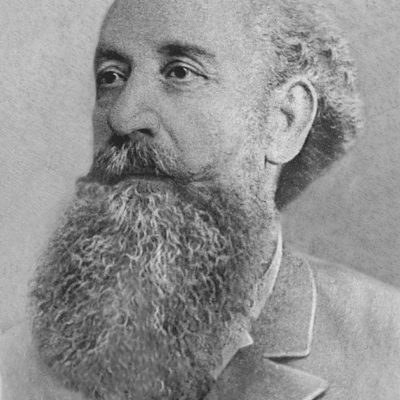
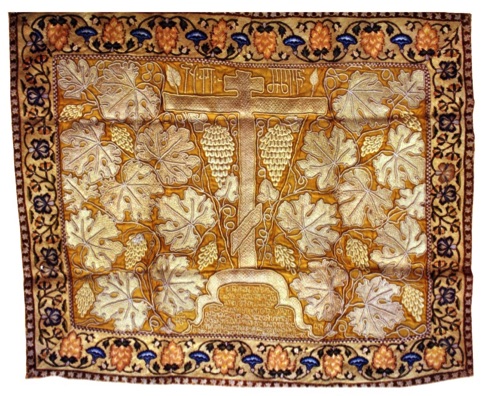
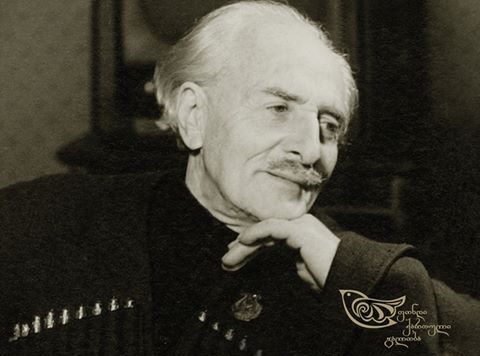
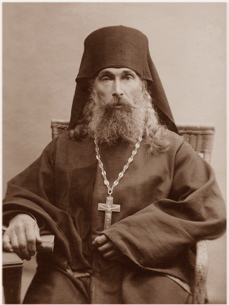
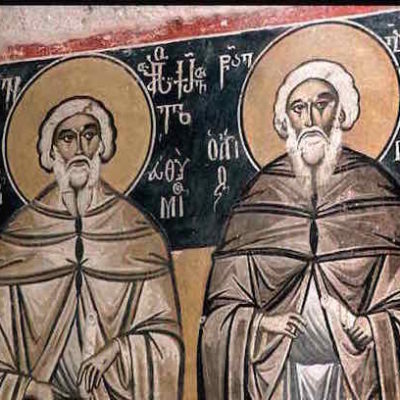
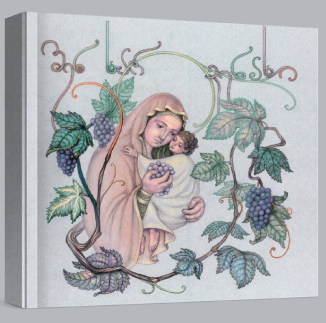
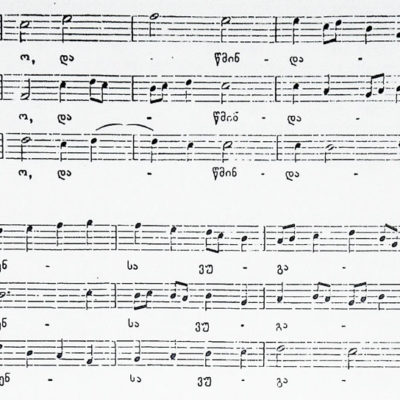
Leave a Reply